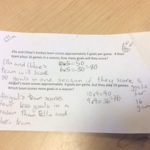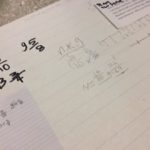In math, students often write either a different method than they actually used to solve a problem, or only pieces of their thinking. We used various technology applications to record student thinking and make it more visible to educators and students themselves.
Team Members
Ashley Gall
Kawartha Pine Ridge District School Board
Devon Arnold
Kawartha Pine Ridge District School Board
Professional Learning Goals
One of our biggest frustrations as teachers, especially with Grade 6 and trying to prepare students for provincial testing, is having to infer student thinking based on what is written on the page.
We continue to learn how to shape our practice (small group instruction, finding misconceptions, assessing student knowledge, thinking, communication and application) based on students recording their thinking and questioning each other using a video tool. We understand now that the gap between what students do during a task and their final product exists. This disconnect is deeper than we had anticipated. Because of class sizes and the daily requirements of teaching, it is difficult to capture all student thinking. Using video allows us to look at student work more flexibly and being able to rewind and revisit a student’s thinking only enhances teacher understanding of what they know.
The inclusion of a media assessment tool gave us the time to stop and watch the video and analyze how students are reasoning, making their understanding more transparent to us than if they were only writing it on a piece of paper. Students were more comfortable talking on the iPad than when a teacher listens in during group work.
We have learned that using media to record student thinking is a powerful assessment tool.
Activities and Resources
- Co-planned math lessons and activities
- Meeting to co-debrief lessons using student video artifacts recorded on the iPad
- Using the video recordings in class as consolidations of the lesson that day or for a minds-on for math lesson the next day
- Ashley met with the board innovations consultant to discuss integration of the iPads in the classroom
- One thing that helped was that the students bought into the project, that they loved watching the videos of their classmates’ thinking, and they felt pride in their thinking and wanted to record how they worked through a problem
- Use of Innovate with iPad: Lessons to Transform Learning in the Classroom by Karen Lirenman and Kristen Wideen
Unexpected Challenges
Our iPads weren’t imaged through the school board, so keeping them up to date was a challenge that sometimes interrupted our use of the iPads. We didn’t buy a docking station or bucket to charge the iPads, therefore we could only charge one or two at a time, and we had to keep them locked up, so charging overnight was difficult.
As teachers, finding a time to meet that worked with both of our schedules was always difficult.
Class sizes are such that, while we are so fortunate to receive the funding, we didn’t have enough iPads to fully integrate them into our practice. We could not have all students working on a problem and recording their thinking (even when utilizing the school resources).
Enhancing Student Learning and Development
Because of the project, our mathematics teaching became more individualized and differentiated. Since we were able to identify gaps in student learning and misconceptions, our teaching became more responsive and adaptive (i.e., by changing the magnitude of numbers in a question, chunking tasks, and giving students entry points into the tasks).
There were many more aha moments when consolidating student thinking using a video than in a traditional BANSHO model. Students were more engaged because of the video format. They were able to name the learning, describe whose strategy they were using and give each other specific feedback based on what they saw. Students could then use feedback that they were given to revisit the task and improve their performance, or then apply it to future tasks.
Through this project, students that previously had a disconnect between what they wanted to say and being able to communicate their thinking in traditional formats, showed an increase in efficacy through using technology applications.
Sharing
In the TLCP cycle we are in now, we have talked about pencil and paper tasks not being the only way to assess student thinking, and how a pencil and paper task does not capture all student reasoning. During moderated marking of student pre- and mid-tests, we brought a combination of student work on paper and video artifacts to share with our division.
During our divisional meetings and staff meetings, we have shared some of our findings about how using recordings of student thinking has added to the level of student engagement and teacher understanding of where students are in the curriculum continuum. We have been actively advocating for other teachers to use various types of tools to assess their students’ thinking.
Project Evaluation
At the beginning of the project, we determined that we would know if our goals had been met in the following ways:
1. We will have a pedagogical blog of our learning as a team.
This didn’t happen. We struggled to have the time to meet and, with the demands of daily teaching, weren’t able to update a blog as we had hoped. We started a few posts and did not end up following through.
Since our project uses video, permissions were tricky and we teach at a school where, due to a lot of legal and custody issues, it is difficult to obtain permissions. We wanted to group students based on ability, not permissions, so the blog became less of a priority.
Our sharing of our learning with our colleagues was more informal, through discussions in the hallway and staff room , and through more formal interactions at division and staff meetings.
2. We will have electronic portfolios for each student to make their math thinking visible (photos, student work products, videos, etc.)
We had planned on using Edsby as a forum for sharing student thinking with their parents. We had hoped to post more about what we are doing in class. Devon only had two parents return the Edsby form. Ashley began using SeeSaw as a student portfolio tool. Using this tool, students and Ashley were able to post various snapshots of daily learning.
3. A series of lessons intentionally designed for better visibility of student thinking.
We have designed many tasks to allow for more visibility of student thinking. On an ongoing basis, when we are planning a task or activity, we think less about what problem will work for the curriculum expectations we are covering and more about how we can use the curriculum as a vehicle for students to show what they know. Our tasks are also designed to invite student interaction and peer feedback.
When reflecting on our learning and the process of the project, we have a few things that we would change or do differently:
- We absolutely love the ease of use with iPads. Our kids having the ability to AirDrop their videos to an iPad makes such a difference. Next time, we would designate one central iPad as “the iPad to AirDrop to.” We would also invest in a hard drive to store the artifacts.
- We would invest in an iPad charging bucket and lock to make it easier to have all iPads charged at once and safely locked
In addition, we would spend more time at the front of the project training kids to the following expectations:
- Video their work, not their face
- Choose a proper work location (everyone around needs to be quiet so the voices can be picked up)
- Edit their videos
- Organize their videos according to a system that fits each individual classroom
Resources Used
Making Thinking Visible: How to Promote Engagement, Understanding, and Independence for All Learners by Ron Ritchhart, Mark Church and Karin Morrison
From Chapter’s website:
A proven program for enhancing students’ thinking and comprehension abilities.
Visible Thinking is a research-based approach to teaching thinking, begun at Harvard’s Project Zero, that develops students’ thinking dispositions, while at the same time deepening their understanding of the topics they study. Rather than a set of fixed lessons, Visible Thinking is a varied collection of practices, including thinking routines, small sets of questions or a short sequence of steps, as well as the documentation of student thinking. Using this process, thinking becomes visible as the students’ different viewpoints are expressed, documented, discussed and reflected upon.
- Helps direct student thinking and structure classroom discussion
- Can be applied with students at all grade levels and in all content areas
- Includes easy-to-implement classroom strategies (the book also comes with a DVD of video clips featuring Visible Thinking in practice in different classrooms)
https://www.amazon.ca/Making-Thinking-Visible-Understanding-Independence/dp/047091551X
Who Owns the Learning? Preparing Students for Success in the Digital Age by Alan November
http://novemberlearning.com/educational-resources-for-educators/books-on-educational-technology/
Assorted mathematics resources by Marian Small, Cathy Bruce and John A. Van de Walle
Used to find questions that we used with our students
Ontario Mathematics Curriculum
http://www.edu.gov.on.ca/eng/curriculum/elementary/math18curr.pdf
Guides to Effective Instruction in Mathematics
Resources developed by the Ministry of Education. Rich tasks for deeper thinking.
http://www.eworkshop.on.ca/edu/resources/guides/Guide_Math_K_6_Volume_1.pdf
EduGAINS – Northwest Catholic District School Board Report on integrating iPads in the classroom
http://www.edugains.ca/resources21CL/InnovationStories/2015-2016/NorthwestCDSB_2015_2016.pdf
Resources Created
These resources will open in your browser in a new tab, or be downloaded to your computer.




